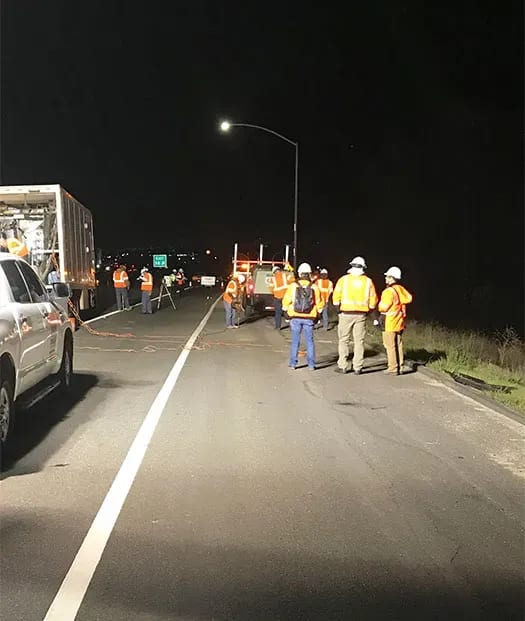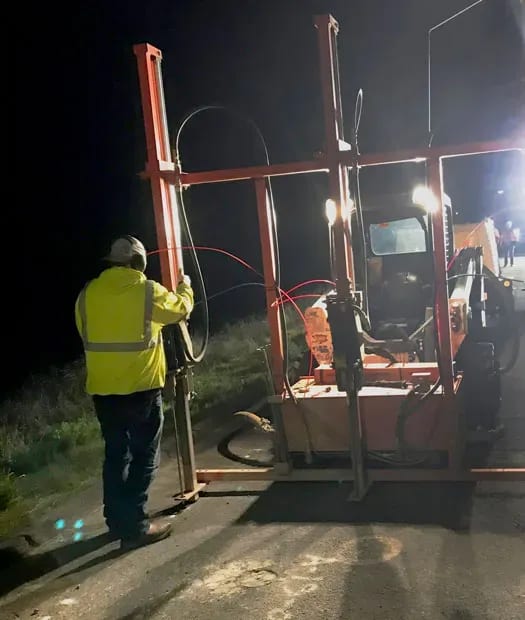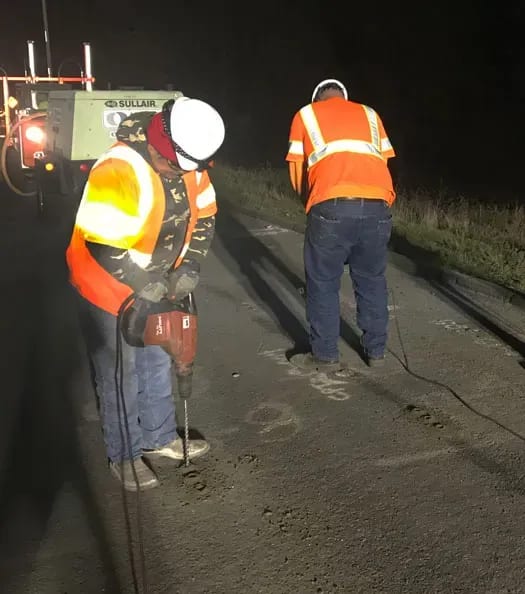Water Main Break Leads to UDI Repair on I-15 in California
Problem
On I-15 in California, north of Lake Elsinore, Caltrans District 8 engineers knew they had a problem when water was observed seeping and bleeding up through the surface of the road at the Temescal Canyon Road exit. Geotechnical studies confirmed a broken water main deep below the surface, and a CIPP liner was inserted to repair the broken pipe. However, officials understood that the water flow would have compromised the soils below the roadway. Costly and time-consuming full-depth repair and excavation down to 25 feet was not a viable option. Looking to stabilize the situation, Caltrans District 8 called Environmental Concepts, a pavement preservation specialist that partners with URETEK on jobs like these.
Analysis
Following the completion of the water main repair work, URETEK crews arrived on site and conducted Dynamic Cone Penetrometer (DCP) tests to locate weak soils and voids. The total project area identified included a 100-foot by 24-foot concrete surface and a 100-foot by 36-foot asphalt surface. In both these areas, weak soils were identified below the surface and a plan was developed to utilize URETEK Deep Injection® (UDI) at two different depths to stabilize the subgrade soils. Included in the total project area was a 24-foot by 48-foot area that sat atop the recently repaired water main. DCP testing confirmed substantial voids 20 feet below the surface, in proximity to the pipe repair. Caltrans officials hoped the entire project could be completed in just one week.
Solution
For this project, local water officials had to sign off on the proposed injection plan, and Caltrans District 8 wanted to fully monitor the repaired water main before, during, and after UDI. Using two crews and a gang drill, URETEK began work and proceeded to stabilize the soils at four feet and eight feet beneath both the concrete and asphalt work areas, protecting the roadway from future settlement issues, and blocking any water infiltration that might one day occur there. Once the broad stabilization project was completed, URETEK began focusing on the deep void spaces in proximity to the recent repair work. This time, UDI was conducted 20 feet below the surface, filling all the identified voids and stabilizing the newly lined water main.
Result
On day eight of the project, URETEK crews packed up and departed the work site. The subgrade soils beneath both the concrete and asphalt surfaces were fully stabilized, and all identified voids in way of the recent water main repair work were filled. The repaired water main was supported by the injection, and no damage occurred as a result of the UDI. Water was removed from the problem areas, and future water infiltration was mitigated. Caltrans officials were pleased with the project outcome.
URETEK Deep Injection® (UDI)
Widely referenced throughout our industry, UDI involves the injection of structural polymer into base and subgrade soils to increase the load bearing capacity. This is achieved by injecting the polymer through small holes drilled directly through the pavement structure to depths determined by site-specific analysis. Our URETEK 486 Star® material flows easily into voids and weak zones within the soil mass below. Through a controlled chemical reaction, the expanding polymer compacts surrounding soils and applies a controlled pressure on targeted areas of the affected pavement above. If needed, a multi-injection design plan is utilized to gently return the pavement to its original grade. The composite material quickly cures into a strong, dimensionally stable, and water-resistant geo-material, providing years of reliable service.
URETEK 486 Star®
URETEK 486 Star® polymer is a two-component, high-density, expanding thermoset polyurethane system. It was developed to be the ideal solution for under-sealing, void filling, lifting of settled pavement, stabilization and stiffening of weak soils, and for encapsulating and sealing buried infrastructure. URETEK 486 Star® is environmentally inert, non-toxic, and resists underground water erosion or weakening due to its industry-leading hydrophobic properties.


